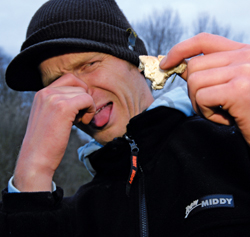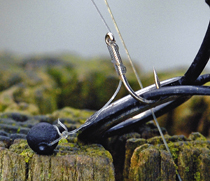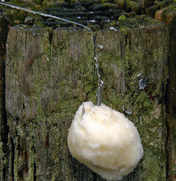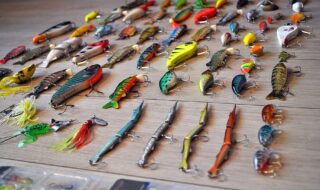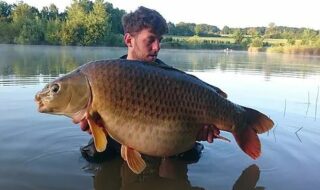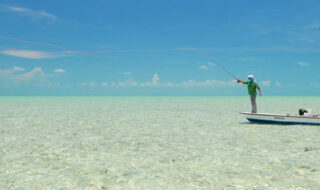Rob Wooton is known for his successes on the open match circuit, but he also loves the solitude of the river. We join him for a session on the Upper Welland.
As much as I’m known for my competitive angling, it can become a tad monotonous if it’s the only thing you ever do! I know some of my fellow matchmen can’t bring themselves to fish for pleasure, but personally I really enjoy the diversity of days away from the match scene.
I ‘discovered’ this lovely length of the Witham close to Barrowden, near Stamford, Lincolnshire because my boss lives in the village. He’s not a keen angler, but he reckoned he had spotted some decent fish in the summer when the water was low and clear.
I knew they were most probably chub from his tentative description, and I traveled from my Leicester home to have a chuck for the first time just before Christmas.
I managed to land one fine chub in a very brief session, and followed that up with several more thoroughly enjoyable visits over the following few weeks. That’s why I’m back here with the photographer today to show you the potential of the venue.
When you hear the name River Welland, you possibly imagine the rather featureless drain-like river flowing through the Fenlands away to the east.
This Upper Welland, though, is a ‘proper’ little river, full of twists and turns and lovely features. What’s more, it’s full of fish! Chub are dominant, but there are other species.
Prevailing conditions always dictate your approach to a day, whether you are a match angler or pleasure angler. It’s all about making the right decisions.
The beauty of this type of fishing is the fact that you don’t need a stack of tackle and you can choose your own swim, unlike in a match. But where do I start?
I’d be hard pressed to tell you where to fish on the lower, featureless Welland, but here on the upper river, features abound and where there are features, invariably there are fish to be found. Just on this short 250m length, there are at least four spots that absolutely scream out ‘fish!’
It’s the state of the river, particularly the colour, which is giving me cause for concern today, though.
One thing is favourable, however, and that’s the fact that the water is subsiding rather than rising. Chub, in particular, are usually more responsive when the water level is falling.
The colour looks an uninviting green, though, suggesting ‘snow melt’ further upstream perhaps. However, it could just be the land run off, but it’s still rather concerning.
On a clear river I’d that say that bread is the number one bait option, but here on this heavily coloured water, I’m going to have to stimulate the chub’s sense of smell rather than their obvious good vision.
Chub are omnivorous creatures and will inspect most passing items as potential food. They are greedy too!
My first thoughts err in the direction of some strongly flavoured pellets or boilies, and no doubt these would tempt a few fish. But there is a cheaper option, which can be just as successful. Say cheese!
It’s relatively inexpensive, and the longer you keep it, the better and smellier it becomes, making it a great bait for coloured-water conditions.
Gorganzolla is my favourite choice and to be quite frank, it stinks worse than a pair of crusty old trawlerman’s socks!
It’s a real hummer and although I could never eat it myself, I know of some fish that will wolf it down, and they are right in front of me!
Before I describe how to approach the actual fishing, let me quickly run through the tackle I’m using. It could hardly be simpler.
My rod of choice is a Middy Carp Bagging Machine feeder rod in its shortest, stiffest configuration at around 11 feet. Set up like this it’s the perfect rod for this kind of small-river chubbing.
My open-faced reel is loaded with 8lb Middy Lo-Viz main line. You need a strong line with fish to 5lb as the target and snags all around.
A hooklength is also sensible to use on snaggy lengths of river. Even the same strength can be okay. It’s the joining knot that causes the weakness, and if you do get snagged there is an option to pull for a break.
My hook choice is a Middy E003 pattern, a hook that’s strong enough in the wire to cope with these big chub. Sizes in the range from 8 to 12 are ideal for big baits like cheese.
My rig has a small bomb attached which is heavy enough to just hold the bait static. I like to have only just enough weight. Repeated casting with a smaller bomb is less likely to scare the fish than if you use a lot of weight.
The hooklength is set between 15 inches to 18 inches, and I will probably shorten it as I see fit through the course of the day if bites become hard to hit.
By using a hooklength I’m able to add in a short hair set-up, onto which I have tied a little black bead. This is a useful trick, as I can mould the cheese around the hair and bead to help the bait stay on the hook and enable me to leave my hook point exposed, which aids penetration on the strike.
That’s it really, except to add that I use a Middy quivertip rod rest head, which always lets me strike quickly. I don’t like those deep, round heads for this type of fishing because the rod can get stuck in my experience.
My first choice of swim is a long, fairly deep, straight run on the edge of some trees that is fishable due to the flow being constant down the peg. It’s usually around 6ft deep under normal conditions, but there is maybe two feet of extra water in the river today. When I’ve fished here before, I’ve caught, so I’m hopeful.
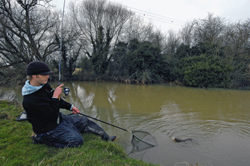 |
| Even though the river is carrying an extra two feet of water and colour, Rob’s smelly baits are too good to resist. |
My initial cast is made to land halfway down the swim. I don’t like to fish too far down straight away. My approach allows the fish a close-by sanctuary to drop back to if they become spooked. I’m thinking like a match angler you see, all the time!
A positive bite comes from the first cast, which is a relief actually, but the fish is hooked briefly before coming off. Drat!
I cast to the same spot again and after five minutes the tip is wrenched round and soon a cheese-loving chub, the first of many I hope, is bullied to the net. You can’t give these fish a second chance of finding sanctuary in tight, snag-ridden swims! It’s a good fish, around 3lb 8oz, but more importantly is the fact that losing that first fish hasn’t spooked the rest of the shoal.
Normally, I’d move pegs now after feeding some bait especially in clear water, but with the river being so high and coloured there are only a couple of other easily fishable swims, so I decide to stay put and see what else I can extract from this reliable swim.
I only get tentative bites from the next five casts, but still strike in case a fish has taken the bait. However, this proves fruitless, so I change hook size to a 12 and use a smaller piece of cheese paste in order to try and see if the culprits are small fish or shy-biting bigger ones.
 |
| Bites from hungry chub can be ferocious, so Rob recommends a shallower-style quivertip-type rest be used when legering to avoid the rod getting jammed when the tip gets wrenched round. |
My next cast flies further down the run, hopefully a more confident fish will take this time! I wait, my hand hovering over the reel, poised to make contact on the strong strike.
I believe that bites should be hit instantly, positive ones especially, as the fish can have the bait off the hook in an instant.
The tip jags round and I meet some solid resistance. It’s all action for a few minutes as another sizeable chub dives for cover. My set-up is up to the job though, and with some force applied and with total confidence in my gear, I manage to turn him, so he is quickly wallowing on the surface and I’m puffing a sigh of relief after a heart-pumping, brief encounter!
The fish weighs in at 4lb 1oz, a cracking chub for a chilly winter’s day, but it’s time to rest the swim and try my luck elsewhere.
I drop into a couple of swims upstream. One in particular looks so ‘chubby’, it’s almost like a page from a textbook.
Take my advice though, even in coloured-water conditions, approach your swim cautiously and quietly, otherwise you can blow your chances of a fish even before you cast in your bait.
The next fish comes after an hour of feeding a few very small balls of cheese in this new swim. The next, and what proves to be the final, good chub of the session turns up out of the blue after a couple of smaller chublets take a fancy to my smelly bait, as the light is fading.
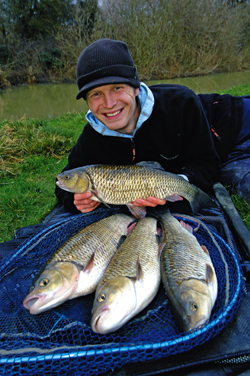 |
| These Upper Welland chub are fighting fit and in perfect winter condition. |
With four stunning chub recorded for my efforts I’m very happy with my day’s efforts.
I feel my success on a not altogether ideal river is down to a combination of sensible watercraft allied to the perfect bait for the prevailing conditions… a real humdinger lump of smelly Gorgonzola cheese!
Top Tip
Don’t be afraid to fish with big baits for chub, as they have massive mouths. However, if you start to get tentative bites it’s best to scale down on hook and bait size until you get a positive take.
Top Tip
Casting large lumps of lead all day will just spook your quarry away from the swim, so try and fish with just enough weight to hold bottom in the current.
Top Tip
Chub normally fish by sight, but they have a great sense of smell too, so when fishing heavily coloured rivers try to fish with the smelliest cheese you can find. It may honk a bit and make you retch, however, chub will home in on it like a heat-seeking missile.
|
|


